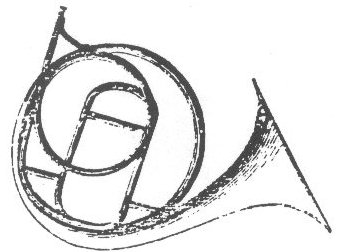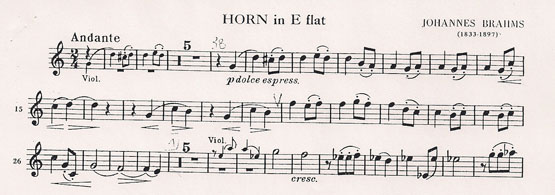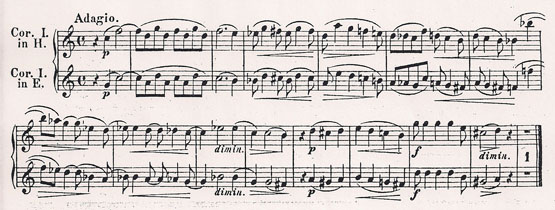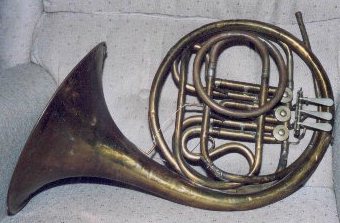Brahms and the Orchestral HornWith Brahms it is all written for natural horn. [1] John Ericson Johannes Brahms (1833-1897) crafted arguably some of the most characteristic parts ever written for the horn. After the invention of the valve in 1814 we see two types of horn in use, natural horns and valved horns. They coexisted for many years in professional use but, on the whole, by the time Brahms was composing his masterworks the natural horn had largely fallen out of use. Yet he continued to write for the natural horn, a fact that opens up many questions both from a purely historical perspective and from a performance perspective today. Orchestral natural horn [2]. 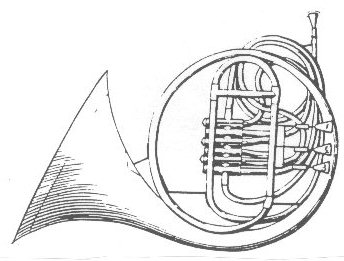
Horn with Vienna valves [3]. In the nineteenth century there were a variety of attitudes toward valves. While we, from our perspective today as valved horn players, would think that the valve was a great invention and that it must have immediately been recognized as such by all parties, the valve actually had a very mixed and rather slow reception. In some areas the natural horn remained in use for many years and it certainly had its strong supporters [4]. Differing opinions circulated on the valved horn; recognition of this fact is essential in understanding the musical reality in which Brahms lived and worked. Among composers, the lines had been drawn by the 1830s. On one side you have composers who were open to the use of valved brass instruments. One composer of this side who actually composed no works for the valved horn, making his example even more interesting, was Felix Mendelssohn (1809-1849). Commenting in 1834 on his overture Die Schöne Melusine, Op. 32 (1833), which featured the horns and trumpets outlining the minor triad (written c'', eb'', g''), Mendelssohn stated that
In other words, the work was composed to require hand stopping by not only the horns but also the trumpets (!), but Mendelssohn was open to the idea of valved instruments playing these parts [6]. On the other extreme you see composers who felt that valved brass instruments were simply a bad idea. One such composer was Karl Gottleib Reissiger (1798-1859). Reissiger was an important musical figure at the time, holding the position of Hofkapellmeister in Dresden during from 1828; this was the court where Richard Wagner (1813-1883) would hold the position of second Kapellmeister (under Reissiger) from 1843-49. Reissiger wrote in 1837 that
His comments about the “colorless monotone” get at the idea that the tone of the horn should have shades and nuances of tonal color, a central characteristic of the tone of the natural horn. Many other later quotations relating to this same idea could be cited [8]. This division between supporters of the valved and supporters of the natural horn is central to understanding what Brahms is getting at in his horn writing, as he is the most successful of those composers whom advocated the natural horn in this period. Brahms studied the hand horn as a youth (along with cello and piano), and the horn was one of the instruments that his father Johann Jakob Brahms (1806-72) performed upon professionally as well. With this background, his clear understanding of the natural horn must be a part of why Johannes Brahms composed for the instrument as late as he did. It is widely known that the Trio, Op. 40 for horn, violin, and piano of Brahms is one of the last and greatest chamber works written for the natural horn. Brahms was quite specific about wanting his Trio performed on the natural horn instead of the valved horn. A very clear source is a letter dated December 7, 1865, to his friend Albert Dietrich, director of the orchestra at Oldenburg, on possible works to perform at a concert during a proposed visit.
Brahms knew he was at this point asking for something unusual, as he asks for the hornist to practice the natural horn “for some weeks before-hand, so as to be able to play it on that.” In other words, he expected that the player did not normally use the natural horn at that time but that the player would be familiar with it from his training in the period and that this really was the sound Brahms wanted in his conception of the work. In a letter to Richard Heuberger Brahms also stated the following in regard to performing the Trio on the hand horn: "If the performer is not obliged by the stopped notes to play softly, the piano and violin are not obliged to adapt themselves to him and the tone is rough from the beginning." [10] In this passage Brahms gets at an important advantage of the natural horn in this work--it is "naturally" softer. The main advantage of the natural horn is however the tonal color and the resulting shadings of tonal color heard automatically with the natural horn. The following is an example: Brahms, Trio, Op. 40, mvt. I For Brahms I believe that this use of the natural horn was at least in part to create a nostalgic mood, retrospective, one looking toward the past and into memories. It is this very element that makes performances on the natural horn of this work perhaps a little problematic for an audience today. Brahms grew up with the natural horn and saw the instrument replaced by the valved horn during his lifetime, as did basically all of the musicians working everywhere outside of France in 1865, as the valved horn only came into wide use after 1850. Audiences today, in contrast, know basically only the valved horn and the concept of the beauty of variations of tonal color on the natural horn is lost on most listeners [11]. The Trio is important in relation to the orchestral horn writing of Brahms in that it clearly points out where he was coming from. Brahms knew the natural horn and wanted it to be performed in his works. In an examination of his orchestral writing the Symphony No. 1, Op. 68, completed in 1876, is an appropriate place to start. While we don’t have the quotations from his writings to shed light on his intentions as we do in the case of the Trio, Brahms in his first symphony makes several musical statements about his intentions in his horn writing. The following is a typical example. Brahms, Symphony No. 1, Op. 68, mvt. II In this example he calls for the horn in E and requests only notes playable on the natural horn. He is consistent with this style of writing throughout the symphony, calling for four horns crooked in pairs in the keys of C, E-flat, E, and H (B-natural in German notation). Even a casual look at the parts will confirm that clearly he is writing for the natural horn or he would not have selected the keys that he selected, the notes that he selected, and the divisions seen melodically between the two pairs of horns crooked in different keys. There are two big issues to consider in relation to this writing. The first is Brahms intentions as notated in the parts; in this case, the intention is clearly to write the parts in a manner that would leave them performable on the natural horn. But the second issue looms large in the background. How did players actually perform these parts in the period? They almost certainly performed the work on the valved horn in early performances. A strong statement that Brahms may be making musically by his continuing to write for the natural horn is this: to write for the natural horn was one of the most anti-Wagner stances he could have taken in relation to the charged musical climate of the period. Even if this was not his intention, he certainly gained something by writing for the natural horn, an almost intangible aspect but one that we, as horn players, are sensitive to. Horn writing conceived for the natural horn is inherently “hornistic;” it has a sound that sounds “right” for the horn, a sound that cannot be mistaken for a part written for another instrument in the same range as the horn. Being as well versed in the natural horn as Brahms was, this “sound” issue alone must have been highly significant. His next major symphonic work, the Symphony No.2, Op. 73, composed in 1877, raises even more questions, most notably with his further request of the B-natural crook. Does Brahms have an axe to grind? This key was an extremely rare key to be found in a natural horn part in the classical period and he must have realized as well that it would be difficult to transpose this key onto the F crook on the valved horn. However, if you finger 123 on the F crook on a valved horn you get the key of B-natural. It is almost as if Brahms is daring the first horn to play this section the “right” way, without transposition, by fingering the B-natural crook with the valves and using natural horn technique. Horn players themselves however seem to have came up with another solution to the difficult transposition even in the period. The famous Leipzig horn teacher and player Friedrich Gumpert (1841-1906) included the above excerpt in the following manner in volume VIII of his Orchesterstudien (Solobuch) für Horn, published between 1886 and 1891 [12]. Brahms Symphony No. 2 excerpt as presented by Gumpert In other words, Gumpert suggested transposing the part not onto the F crook but onto the E crook, where the transposition would be at an interval of the fourth instead of the augmented fourth required on the F crook. In this period crooks were still used on the valved horn, so this approach makes perfect sense [13]. In the Symphony No. 2 Brahms also requested the C, D, E, and G crooks. Valved horns were available with all of these crooks at the time. Horns constructed to take terminal crooks could typically be crooked as high as B-flat alto. Even fixed leadpipe models could take crooks in the period. This is notable in relation to the G crook as a horn of the general design illustrated below (this particular horn is a Huttl from the turn of the century) could be crooked as high as horn in G. As it stands in the photo this horn is in F; but with a straight tuning slide (the tuning slide on the horn has an extra turn) this horn would stand in G. We can’t be sure, but perhaps this had some influence on Brahms to not request crooks higher than G. One of his next orchestral works was his Academische Festouverture [Academic Festival Overture], Op. 80, composed in 1880. In this work we can glean another significant insight from passage below. Brahms, Academic Festival Overture, Op. 80 In this passage he requests certain notes to be performed Gestopft [stopped] at times in all four parts. These notes would have been performed stopped on the natural horn in this context but would have been performed open on the valved horn. This notation could be seen as an admission by Brahms that he realized his horn parts were in fact being performed on the valved horn; the notation makes it clear however that these specific locations were intentional stopped effects that must be performed stopped even if performed on the valved horn [14]. This notation clearly harkens to statements of Hector Berlioz (1803-1869). In his Grand traité d’instrumentation et d’orchestration modernes (1843) he wrote,
This passage is especially relevant to his own Symphonie Fantastique (1832), movement IV, where in a note to the published score (1845) Berlioz requested at the beginning of the movement that the horns "produce the stopped tones with the hand without using the valves" ("faites les sons bouchés avec la main sans employer les cylindres"); this instruction is almost universally ignored today [16]. Berlioz, Symphonie Fantastique, mvt. IV Like Berlioz, Brahms also clearly did not want his intentional stopped horn effects to be lost if performed on the valved horn. In fact, you can see notations of this same type in the first symphony of Brahms at the beginning of the second movement, so he was very aware of this issue right from the beginning of his symphonic writing. As we arrive at the later orchestral works of Brahms we see that he continues to write in a way that his parts are at least theoretically playable on the natural horn. In these works Brahms pushes the limits of natural horn technique with the knowledge that the parts would in fact most likely be performed on the valved horn. Passages such as the following are playable on the natural horn, but most would agree that this would lay better on the valved horn. Brahms, Symphony No. 3, Op. 90, mvt. III The die was cast, he wrote the way he wrote (for the natural horn), and players played the way they played (on the valved horn). One final thought. Is it really natural horn writing if nobody played it on natural horn at the time of composition? Brahms did certainly write only for the natural horn, but there is a case to be made that he knew at some point that players would play the parts on valved horns and at that point the writing does in a sense cease to be natural horn writing and becomes something of an exercise in notations and transposition. But what an exercise! NOTES: 1. This article is expanded from materials presented in my session Natural and Valved Horns in the Nineteenth Century at the 2001 International Horn Symposium in Kalamazoo, Michigan. 2. Illustration from Georges Kastner, Manuel Général de Musique Militaire (Paris: Didot Frères, 1848), plate XIV. 3. Illustration from Joseph (sic) Kail, Scala für das chromatische Tasten-Waldhorn in F und E (Prague: Marco Berra, [1830/31]). 4. See for example my article, “Trashing the Valved horn? Comments on Valved and Natural horns from Turn-of-the-Century England,” The Horn Call 29, no. 1 (November, 1998), 53-56. A version of this article is online in the IHS website. 5. Felix Moscheles, ed., Letters of Felix Mendelssohn to Ignaz and Charlotte Moscheles (1888; repr. Freeport, NY: Books for Libraries Press, 1970), 97, cited in David Whitwell, A New History of Wind Music (Evanston, IL: The Instrumentalist, 1972), 26. 6. That Mendelssohn did not think much, however, of the keyed trumpet is shown in a letter of February 14, 1831 to clarinetist Heinrich Bärmann (1784-1847), cited in Edward H. Tarr, "The Romantic Trumpet," part 1, Historic Brass Society Journal 5 (1993), 248, footnote 90, trans. Tarr. Of the trumpeters in Rome Mendelssohn wrote,
7. C. G. Reissiger, "Über Ventilhörner und Klappentrompeten," Allgemeine musikalische Zeitung 39 (September, 1837), 610, trans. in Ernest H. Gross III, "The Influence of Berlioz on contemporary nineteenth century use of brass instruments," part 1, Brass Bulletin 67 (1989), 21. 8. “Trashing the Valved Horn?," ibid. 9. Henry S. Drinker, The Chamber Music of Johannes Brahms (Philadelphia: Elkan-Vogel, 1932), 112. Another translation of the key phrase of this quote confirms the intent for the work to be performed on the natural horn, reading “Your horn player will do me a great favour if, like the Karlsruhe man, he practices the natural horn for some weeks beforehand and plays it on that” (Albert Dietrich and J. V. Widman, translated Dora E. Hecht, Recollections of Johannes Brahms [London: Seeley, 1899], 48, cited in John Humphries, The Early Horn: A Practical Guide [Cambridge: Cambridge University Press, 2000], 101). 10. Drinker, 111-112. 11. The work is also considerably more difficult on the natural horn than on the valved horn--I would estimate that it is towards 50% more difficult to perform on the natural horn, depending on your comfort level with the instrument. As a horn player interested in historic performance practices I have worked on the Trio the way Brahms intended, on the natural horn, hitting the work very hard between the fall and spring semesters just a few years back in preparation for a February performance. I would have enjoyed performing the Trio in recital on the natural horn, but once we got into the rehearsals I opted to instead to use the valved horn. The balance and color of the work was certainly different on the natural horn but I personally am comfortable with presenting a historically informed performance on the valved horn, creating as much of the color and retrospective mood of the natural horn as possible without actually using a hand horn. And after working hard on the work on natural horn it was suddenly very easy to play on the valved horn. 12. This dating is based on the listing of this work in volume 10 of Friedrich Hofmeister, ed. Handbuch der Musikalischen Literatur (Leipzig: Hofmeister, 1893), 260, which covers the years 1886-91. All of the published works of Gumpert misspell his family name as “Gumbert” as is noted in Norman Schweikert, “Gumpert, not Gumbert!,” The Horn Call 1, no. 2 (May, 1971), 45-46. Also refer to this article in Horn Artcies Online. 13. See for example “A Letter From Anton Horner,” The Horn Call 23, no. 2 (April, 1986), 91-93, and also my article “Crooks and the 19th-Century Horn,” The Horn Call 30, no. 1 (November, 1999), 49-58. 14. Brahms thus clearly intended this passage to have somewhat distant sounding “natural horn” stopping which is less harsh and buzzy than the fully stopped sound that is typical in performances today. 15. Hector Berlioz, A Treatise On Modern Instrumentation and Orchestration, trans. Mary Cowden Clarke (London: Novello, n.d.), 141-142. 16. See Hector Berlioz, Fantastic Symphony (New York: W. W. Norton, 1971), ed. Edward T. Cone, 122, for this marking, not seen in all editions of the work (noted in Jeffrey Snedeker, "Joseph Meifred's Méthode pour le Cor Chromatique ou a Pistons, and, Valved Horn Performance in Nineteenth-Century France” [D.M.A. diss., University of Wisconsin-Madison, 1991], 77-79). Today, this passage is probably most commonly performed muted, a notation actually present in some modern editions of the work. Copyright John Ericson. All rights reserved. |
